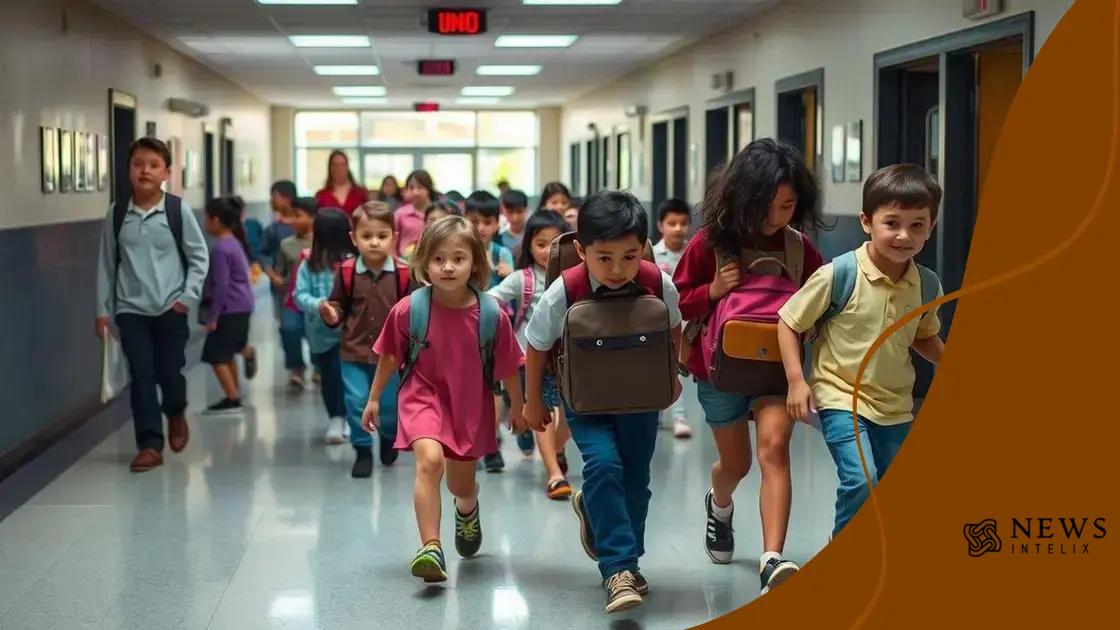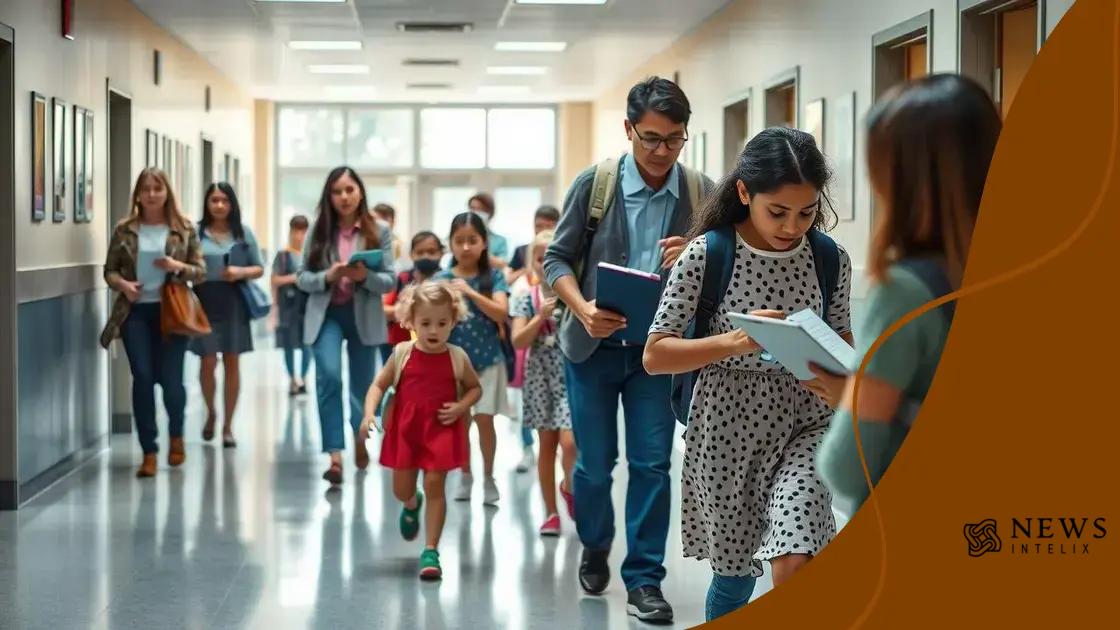Student safety drills now nationwide: what you need to know

Student safety drills are essential for preparing students and staff for emergencies, ensuring they know how to respond quickly and effectively through regular evaluations and engaging safety awareness initiatives.
Student safety drills now nationwide are designed to protect our children in emergencies. Have you ever thought about how prepared your child’s school really is? Let’s explore what these drills involve and why they matter.
Understanding the importance of safety drills
Safety drills are crucial for preparing students and staff in schools. Understanding the importance of these drills helps create a safer environment. By practicing different scenarios, schools ensure that everyone knows how to respond in emergencies.
Why Safety Drills Matter
Understanding the importance of safety drills helps reinforce safety culture within schools. These practices can significantly reduce chaos during actual emergencies. Knowing what to do can save lives, time, and reduce injuries.
Key Benefits
- Improves student preparedness for emergencies.
- Enhances overall safety awareness in the school.
- Builds confidence in handling unexpected situations.
- Creates a culture of safety among staff and students.
Another vital point is that safety drills encourage communication among students and staff. During a drill, everyone plays a role, fostering teamwork and cooperation. This dynamic prepares students not only for emergencies but also for real-life collaborative situations.
Moreover, frequent drills allow schools to assess their readiness and refine their protocols. By regularly evaluating effectiveness, schools can enhance their response strategies. This ongoing improvement is crucial in adapting to new challenges and ensuring a well-prepared community.
Feedback and Improvements
Gathering feedback post-drill provides valuable insights. It’s essential to discuss what worked well and what could be improved. Engaging students in the reflection process enhances their understanding of safety protocols and empowers them to contribute to future drills.
Ultimately, incorporating these safety measures into routine school activities is vital. The more familiar students are with emergency procedures, the more effectively they can respond when needed.
Types of safety drills in schools
Understanding the types of safety drills in schools is essential for effective emergency preparedness. Schools implement various drills to prepare students and staff for different scenarios. Knowing how these drills work can help build a safer environment for everyone.
Fire Drills
One of the most common safety drills is the fire drill. These drills teach students how to exit the building quickly and safely during a fire. They practice moving in a calm and orderly manner to designated assembly points. Learning to respond calmly in a fire emergency can save lives.
Lockdown Drills
Lockdown drills are crucial for preparing students for potential threats inside the school. During these drills, students learn to secure their classrooms, stay quiet, and follow instructions from teachers. This training helps ensure that everyone knows what to do if a dangerous situation arises.
Evacuation Drills
Evacuation drills are designed for situations where students may need to leave the building due to emergencies like gas leaks or natural disasters. During these drills, students practice quickly exiting the school while remaining calm. It’s important to have clear evacuation routes, which are regularly communicated to everyone.
Earthquake Drills
In areas prone to earthquakes, schools conduct earthquake drills. These practice sessions teach students to “drop, cover, and hold on” to protect themselves. Understanding this response can reduce panic and injury during an actual earthquake.
Each type of drill serves an important role in enhancing school safety. Repeated practice boosts confidence and ensures students know how to respond in emergencies. Schools must incorporate a variety of drills to cover different potential threats, creating a comprehensive safety plan for all.
Furthermore, engaging parents and the community in understanding these drills enhances overall preparedness. School systems often host workshops or informational sessions to explain drill procedures. Such initiatives help build a culture of safety that extends beyond the classroom.
Best practices for conducting drills

Implementing best practices for conducting drills is vital for maximizing the effectiveness of safety training in schools. These practices help ensure that students and staff are prepared for emergencies, allowing them to respond quickly and effectively.
Plan Regular Drills
Scheduling regular drills is essential to keep everyone familiar with procedures. Drills should be conducted at various times throughout the year to simulate real-life scenarios. This variety helps prevent complacency and keeps students engaged.
Involve the Whole School Community
Engaging the entire school community in drills enhances preparedness. Involving teachers, staff, students, and even parents fosters a culture of safety. This involvement encourages everyone to take emergency procedures seriously.
- Encourage feedback from participants after drills.
- Provide clear instructions before each drill.
- Use real-life scenarios to make drills relatable.
Additionally, feedback is crucial for improvement. After each drill, it’s important to gather input from students and staff. This feedback can identify challenges and areas for improvement, ensuring each drill becomes more effective.
Another best practice is to incorporate discussions about drills into classroom activities. This approach reinforces the importance of safety measures and keeps the subject fresh in students’ minds. By weaving these topics into lessons, teachers can help students internalize their roles during emergencies.
Evaluate and Adjust Procedures
Regular evaluation of drill procedures is necessary to adapt to changing situations. For example, if a new school layout is introduced, evacuation routes may need to be re-evaluated. Schools should continuously assess their response strategies, refining them as needed to enhance safety.
Incorporating technology can also improve drills. Using simulations or digital checklists can provide modern ways for students and staff to learn their roles. Technology can make lessons more engaging and relatable.
Engaging students in safety awareness
Engaging students in safety awareness is a crucial aspect of preparing them for emergencies. When students are actively involved in safety discussions and activities, they are more likely to retain information and respond effectively during crises.
Interactive Safety Workshops
One effective method is to conduct interactive workshops. These sessions allow students to participate in learning about safety procedures. Instead of just passive learning, students can engage through simulations and role-playing scenarios that make the information more relatable and memorable.
Safety Awareness Campaigns
Another way to promote safety awareness is through campaigns. Schools can organize events like “Safety Week,” where daily themes focus on different aspects of safety. Involving students in planning these campaigns encourages ownership and reinforces their understanding of the material.
- Posters and artwork highlighting safety tips.
- Presentations by students on various safety topics.
- Interactive quizzes to test knowledge on safety procedures.
Additionally, creating safety clubs or committees can foster ongoing engagement. Students can discuss safety issues, suggest improvements, and even lead drills. This active participation cultivates a sense of responsibility and leadership among students.
Using technology is another impactful way to engage students. Schools can implement apps or websites that provide safety tips and resources. Online platforms can facilitate discussions and share important updates. This way, students can stay informed and prepared.
Peer-to-Peer Learning
Utilizing peer-to-peer learning is highly effective. Older students can mentor younger ones, sharing their knowledge and experiences regarding safety procedures. This approach not only benefits the younger students but also reinforces the older students’ understanding of safety protocols.
Overall, involving students in safety awareness initiatives creates a proactive school culture. When students feel informed and invested in their safety, they are more likely to act responsibly during emergencies. This active engagement helps ensure a safer environment for everyone.
Evaluating the effectiveness of safety drills
Evaluating the effectiveness of safety drills is essential to ensure that schools are prepared for emergencies. Regular assessments help identify strengths and weaknesses in current procedures. By analyzing drills, schools can improve safety measures and training.
Gathering Feedback
One crucial step in evaluation is collecting feedback from participants. After each drill, teachers and students should be encouraged to share their experiences. This input can shed light on what worked well and what needs improvement.
Observing Performance
During drills, having staff observe and take notes can provide valuable insights. Observers can assess how well students and faculty followed the procedures. They can look for any hesitations or confusion during the drill that could indicate areas needing more focus.
- Were students able to follow directions easily?
- Did participants remain calm under pressure?
- Were evacuation routes clear and effective?
Furthermore, conducting post-drill debriefings can facilitate discussions about performance. These sessions allow everyone to voice their thoughts and share any concerns. Understanding different perspectives will enhance the evaluation process.
Implementing Changes
Based on the evaluation findings, adjustments should be made to improve future drills. Changes might include revising procedures, enhancing training programs, or increasing the frequency of drills. Schools should view evaluations as opportunities to strengthen their safety protocols.
Analyzing drill effectiveness is not just about identifying problems. It also involves celebrating successes. Recognizing when drills are performed well can motivate students and staff. Positive reinforcement encourages continued participation and focus on safety.
Incorporating technology can also enhance the evaluation process. Using apps or software to track drill performance enables schools to analyze data efficiently. This data can reveal trends and help schools make informed decisions about safety training.
FAQ – Frequently Asked Questions about School Safety Drills
Why are safety drills important in schools?
Safety drills prepare students and staff for emergencies, ensuring everyone knows how to respond quickly and effectively.
How often should safety drills be conducted?
Safety drills should be held regularly throughout the school year to keep students and staff familiar with emergency procedures.
What are the key components to evaluate after a drill?
Key components to evaluate include participant feedback, adherence to procedures, and any challenges encountered during the drill.
How can students be engaged in safety awareness?
Students can be engaged through interactive workshops, safety campaigns, and peer-to-peer learning initiatives.
